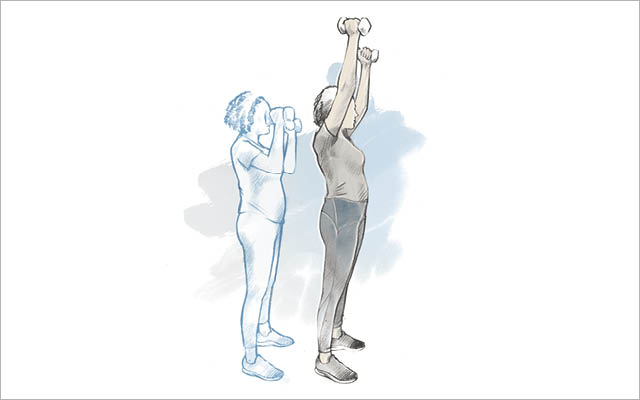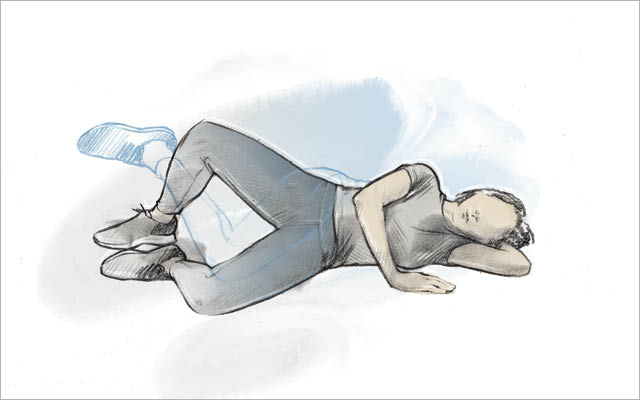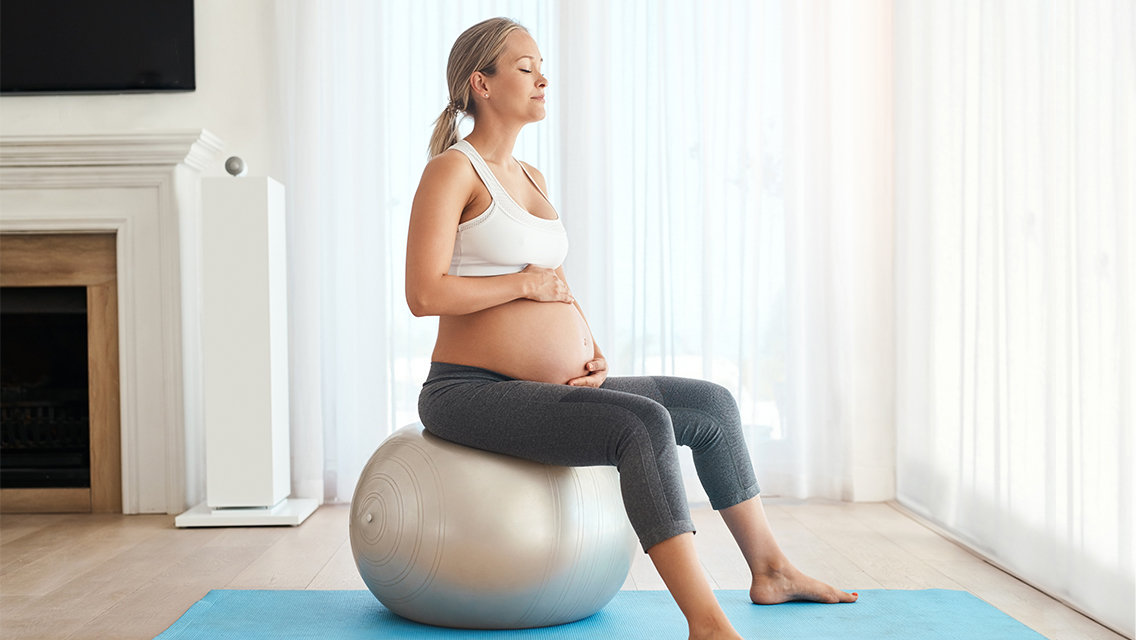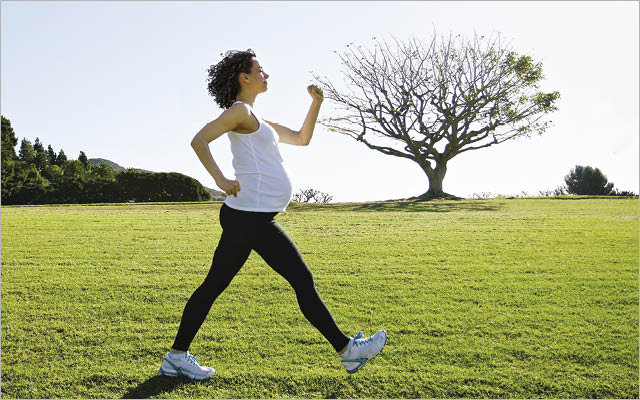First Trimester: Weeks 0 to 12
Respect early symptoms of pregnancy and be willing to adapt. Take this time to understand your body and prepare for the changes ahead.
The first trimester of pregnancy is often viewed as a time to maintain fitness, with little need to modify your workouts — but there are some adjustments worth making now.
“Just because you don’t look pregnant yet doesn’t mean you don’t have a reason to adapt,” says California-based coach Brianna Battles, MS, CSCS, founder of the Pregnancy and Postpartum Athleticism program. “It’s important to start out with a mindset of adaptability and willingness to honor your varying energy levels.”
Rather than trying to commit to a rigid routine and pushing through fatigue or nausea, give yourself a break. Choose exercises that require little preparation; take extra time to transition between movements; stay well hydrated; and prioritize sleep.
“You’re exhausted and you may not feel good,” but those things aren’t visible, says Stephanie Winters, NASM-CPT, a personal trainer and instructor at Life Time Academy in Chanhassen, Minn. “You have to remind yourself that you’re growing a human. It’s like running a marathon every day.”
The first trimester is also a time to plan for changes you’ll experience later. “It’s a good idea to start being more aware of your posture and daily activities that may be adding more stress to your spine and to your pelvic floor,” says Theresa Plasencia, MPT, a Twin Cities–based women’s-health physical therapist. “It’s also an ideal time to learn how to engage your core and connect with your breath.”
Strive to understand your tendencies during exercise, Battles advises, and learn how to address them before the baby gets in the way. When some women attempt to engage their core during exercise, for example, it may result in bearing down or pushing the pelvic floor downward. During exertion, you want to instead feel a gentle lift of the pelvic-floor muscles.
Additionally, some women put pressure into the linea alba — the connective tissue that supports the abdominal wall — which looks like your belly is pushing out, or in the case of diastasis recti, coning at the center of the abdomen. The harder your core has to work during an exercise, the more you should feel your belly drawing in and tightening.
“Knowing how to connect with breathing strategies can support you during the rest of your pregnancy and postpartum,” Battles says. (For more on this, see “Connect With Your Core” below.)
A proactive approach now can also help stabilize the pelvis and prevent symphysis pubis dysfunction (SPD) and sacroiliac joint dysfunction (SJD) later in the pregnancy.
“Typically, women don’t experience issues such as SPD or SJD in the first trimester, but it’s good for them to use exercise to start stabilizing their pelvis early on,” explains Lindsay McCoy, an exercise physiologist in Minneapolis and cofounder of the One Strong Mama program. McCoy recommends incorporating moves that strengthen the hips, such as lateral-band walks.“Prehab before rehab,” she advises. “It’s much more effective.”
Exercises to Try
Kettlebell Deadlift: The functional movement of lifting a heavy object off the ground is a huge part of motherhood and life, as well as a great way to strengthen your posterior chain and dial in good breathing strategy.
 Illustration: James Carey
Illustration: James Carey- Stand straddling a moderately heavy kettlebell. Inhale as you hinge at your hips and bend your knees to lower your arms toward the kettlebell, keeping your shins vertical.
- Grip the handle, then exhale and drive through your heels to rise to standing.
- Inhale as you return the weight to the floor.
- Perform three sets of 10 to 12 reps.
Dumbbell Overhead Press: The first trimester is a good time to start building upper-body strength to prepare for all the time you’ll soon spend carrying baby.
 Illustration: James Carey
Illustration: James Carey- Hold two dumbbells at shoulder height with palms forward. Check in with your alignment, setting your ribs directly over your hips. Inhale.
- Exhale, then press the weights overhead, keeping ribs stacked over hips.
- Inhale as you lower the weights to the starting position.
- Perform three sets of 10 to 12 reps.
Internal and External Hip Rotation: This exercise strengthens the musculature around the hips, which can minimize and prevent hip discomfort and low-back pain.
 Illustration: James Carey
Illustration: James Carey- Lie on your right side with hips and ankles stacked and knees bent at 45 degrees.
- Keeping your ankles together, lift your left knee to externally rotate your left hip.
- Then bring your knees together and lift your left foot to internally rotate your hip.
- Continue internally and externally rotating your hips for one minute, then repeat on the opposite side for one minute.
- To make it harder, place a ball between your knees or have a partner gently give resistance for you to push against.
This originally appeared in “Fit for Two” in the April 2019 print issue of Experience Life.
Connect With Your Core
Exercising safely during and after pregnancy is less about choosing specific movements and more about applying good strategy to how you move.
One of the most important choices you can make is to connect with your deep core muscles — particularly your pelvic floor, transversus abdominis (TA), and diaphragm — so they can support you during exercise. Following is a quick tutorial for connecting with these muscles.
- Practice good alignment: When you’re properly aligned, your pelvic floor, TA, and diaphragm communicate better and can more effectively stabilize your core, support your pelvic organs, and prevent leakage. While exercising, aim to keep your rib cage stacked over your hips and maintain a neutral pelvis. Avoid flaring your ribs or clenching or tucking your bum.
- Use your breath: Inhale deeply through your nose and focus on expanding your rib cage (as opposed to letting your chest rise or pushing your belly out), which will cause your diaphragm to expand and your pelvic floor and TA to gently relax. Then exhale through pursed lips, as if blowing out a candle. Your diaphragm will contract, your pelvic floor will gently recoil, and you’ll feel tension in your abdomen as your TA engages. It is just as important to be able to inhale and relax your pelvic floor and abs as it is to exhale and engage them.
- Coordinate your breath with movement: When performing a lift or exercise with a distinct work or concentric phase, exhale to connect with your core just before the work phase. Continue to exhale and stay engaged through the work, then inhale to relax on the movement’s eccentric or rest phase. If you feel you need more support in the eccentric phase, or if you find that you’re not relaxing your pelvic floor when you inhale, you can alternatively exhale through the entire rep and inhale between reps. The more demanding the exercise, the more you may need to intentionally recruit your pelvic floor and TA to support you. If an exercise has no distinct work or rest phase (such as running or holding a plank), focus on maintaining good alignment and breathing at your rib cage.




This Post Has 0 Comments